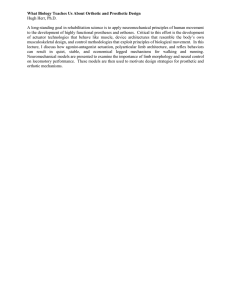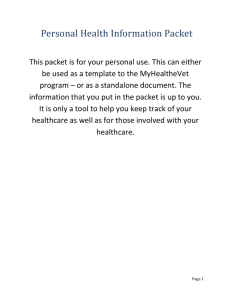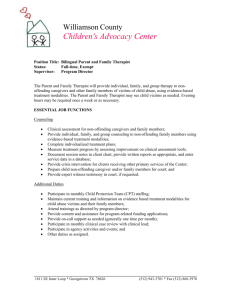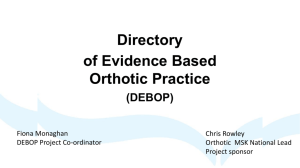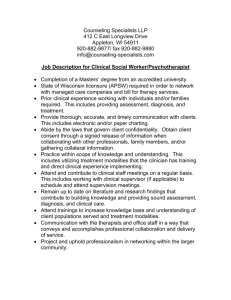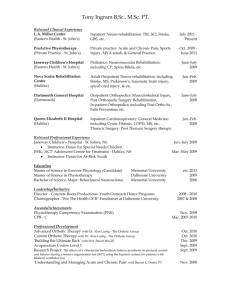subchapter 48C - SCOPE OF PHYSICAL THERAPY PRACTICE
advertisement
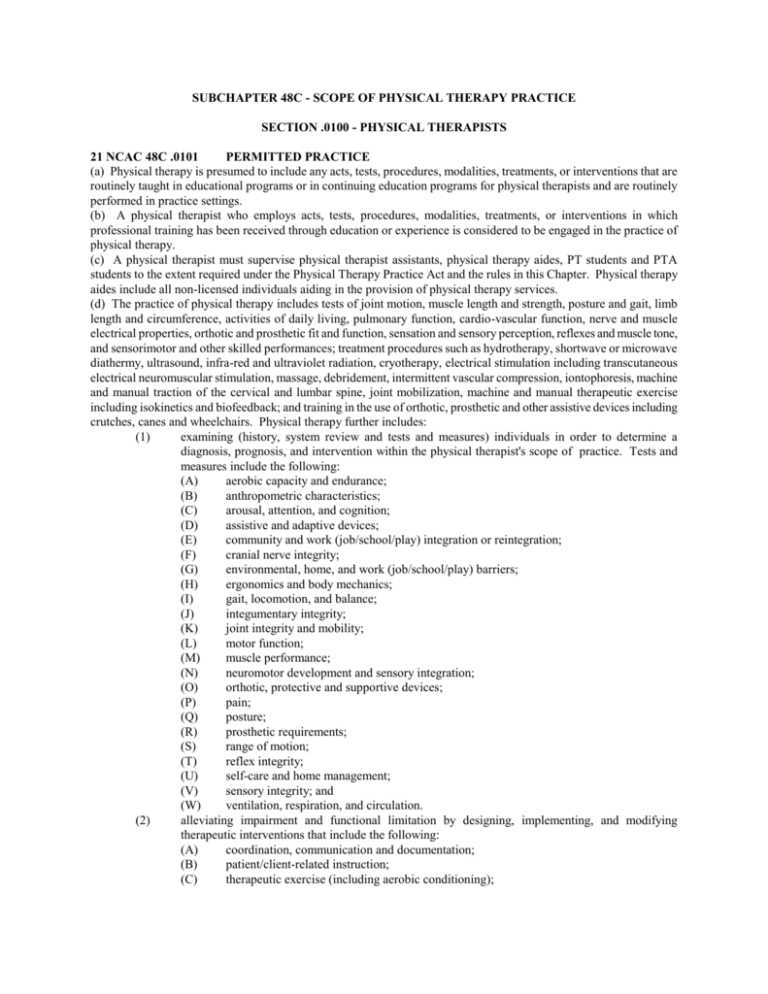
SUBCHAPTER 48C - SCOPE OF PHYSICAL THERAPY PRACTICE SECTION .0100 - PHYSICAL THERAPISTS 21 NCAC 48C .0101 PERMITTED PRACTICE (a) Physical therapy is presumed to include any acts, tests, procedures, modalities, treatments, or interventions that are routinely taught in educational programs or in continuing education programs for physical therapists and are routinely performed in practice settings. (b) A physical therapist who employs acts, tests, procedures, modalities, treatments, or interventions in which professional training has been received through education or experience is considered to be engaged in the practice of physical therapy. (c) A physical therapist must supervise physical therapist assistants, physical therapy aides, PT students and PTA students to the extent required under the Physical Therapy Practice Act and the rules in this Chapter. Physical therapy aides include all non-licensed individuals aiding in the provision of physical therapy services. (d) The practice of physical therapy includes tests of joint motion, muscle length and strength, posture and gait, limb length and circumference, activities of daily living, pulmonary function, cardio-vascular function, nerve and muscle electrical properties, orthotic and prosthetic fit and function, sensation and sensory perception, reflexes and muscle tone, and sensorimotor and other skilled performances; treatment procedures such as hydrotherapy, shortwave or microwave diathermy, ultrasound, infra-red and ultraviolet radiation, cryotherapy, electrical stimulation including transcutaneous electrical neuromuscular stimulation, massage, debridement, intermittent vascular compression, iontophoresis, machine and manual traction of the cervical and lumbar spine, joint mobilization, machine and manual therapeutic exercise including isokinetics and biofeedback; and training in the use of orthotic, prosthetic and other assistive devices including crutches, canes and wheelchairs. Physical therapy further includes: (1) examining (history, system review and tests and measures) individuals in order to determine a diagnosis, prognosis, and intervention within the physical therapist's scope of practice. Tests and measures include the following: (A) aerobic capacity and endurance; (B) anthropometric characteristics; (C) arousal, attention, and cognition; (D) assistive and adaptive devices; (E) community and work (job/school/play) integration or reintegration; (F) cranial nerve integrity; (G) environmental, home, and work (job/school/play) barriers; (H) ergonomics and body mechanics; (I) gait, locomotion, and balance; (J) integumentary integrity; (K) joint integrity and mobility; (L) motor function; (M) muscle performance; (N) neuromotor development and sensory integration; (O) orthotic, protective and supportive devices; (P) pain; (Q) posture; (R) prosthetic requirements; (S) range of motion; (T) reflex integrity; (U) self-care and home management; (V) sensory integrity; and (W) ventilation, respiration, and circulation. (2) alleviating impairment and functional limitation by designing, implementing, and modifying therapeutic interventions that include the following: (A) coordination, communication and documentation; (B) patient/client-related instruction; (C) therapeutic exercise (including aerobic conditioning); (D) (3) History Note: functional training in self-care and home management (including activities of daily living and instrumental activities of daily living); (E) functional training in community and work (jobs/school/play) integration or reintegration activities (including instrumental activities of daily living, work hardening, and work conditioning); (F) manual therapy techniques (including mobilization and manipulation); (G) prescription, application, and fabrication of assistive, adaptive, orthotic, protective, supportive, and prosthetic devices and equipment that is within the scope of practice of physical therapy; (H) airway clearance techniques; (I) wound management; (J) electrotherapeutic modalities; and (K) physical agents and mechanical modalities. preventing injury, impairment, functional limitation, and disability, including the promotion and maintenance of fitness, health, and quality of life in all age populations. Authority G.S. 90-270.24; 90-270.26; Eff. December 30, 1985; Amended Eff. December 1, 2006; April 1, 2003; August 1, 2002; August 1, 1998; December 1, 1990; October 1, 1989; April 1, 1989.

